Too HOT!
This last Sunday, on Father’s Day, my hometown of Phoenix, Arizona experienced a
blistering temperature of 118°F (48°C), which tied the day’s record. It was also the 5th highest temperature in recorded history for the city.

Many of you wrote in with questions and concerns regarding aircraft performance under such intense conditions for Phoenix, as well as shared articles of canceled flights (see Links, below.)

How many times must we tell the clueless media that there’s TWO pilots up front? THE PILOTS decided to turn back!
As far as I can tell, it looks like only one flight had an “air turn back” due to the hot temps. A 78-passenger Embraer 175 Regional Jet, which operates as “United Express,” turned back to KIAH (Houston) because Phoenix had reached the upper limit of its performance.
The aircraft probably could have safely landed. However, part of the certification for any aircraft requires the testing of takeoff, landing, climb and cruise data under myriad circumstances—hot, cold, and all manner of precipitation. In this case, the performance charts for the plane apparently topped out at 118°F. Any hotter, and the plane would be outside the tested range. FAA regulations always err on the side of caution, so these numbers cannot be “extrapolated” to a higher temperature; they must be actually tested.
So, how do higher temperatures actually affect performance ?
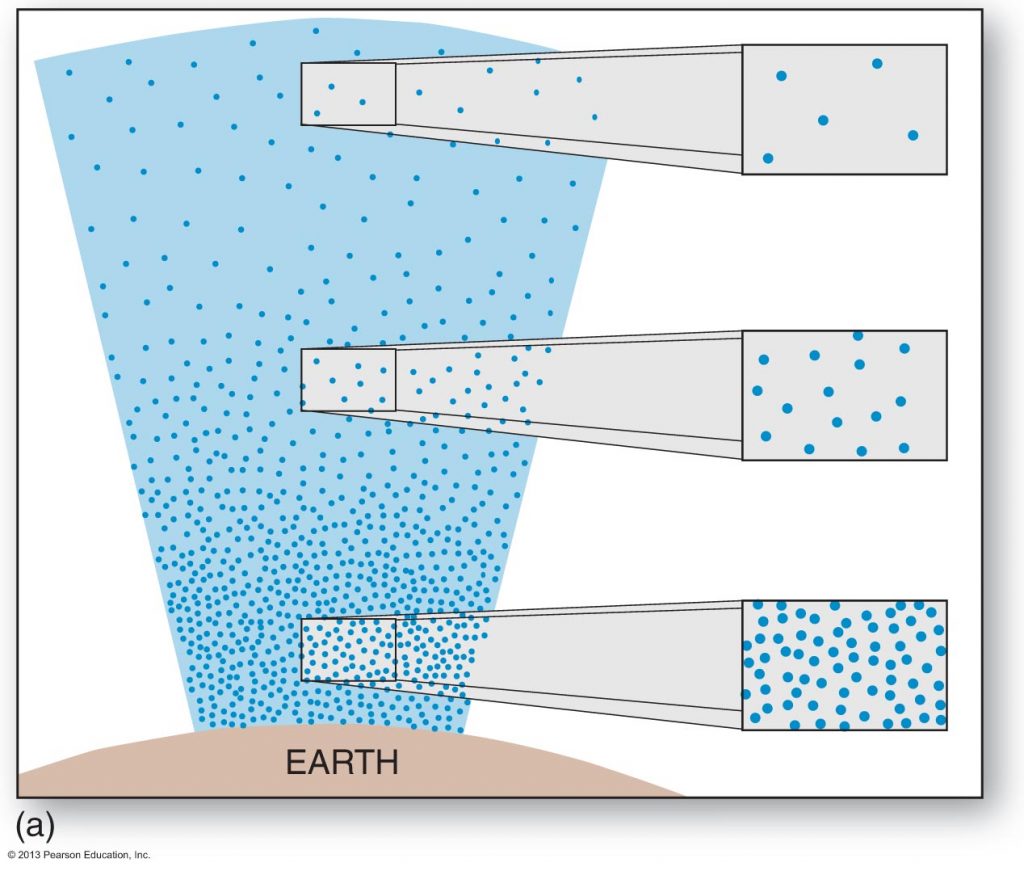 Aerodynamically, airplanes like to fly in thick air. As you most likely know, the higher the altitude, the thinner the air. Go higher, where the air is thinner, and performance suffers: the longer the takeoff roll, the poorer the climb rate, and the longer the landing roll. (Jet engines prefer thin air, but that is beyond this discussion.)
Aerodynamically, airplanes like to fly in thick air. As you most likely know, the higher the altitude, the thinner the air. Go higher, where the air is thinner, and performance suffers: the longer the takeoff roll, the poorer the climb rate, and the longer the landing roll. (Jet engines prefer thin air, but that is beyond this discussion.)
Temperature is also a major factor. The hotter the temperature, the thinner the air, and thus the poorer the performance.
..
This phenomena is called Density Altitude.
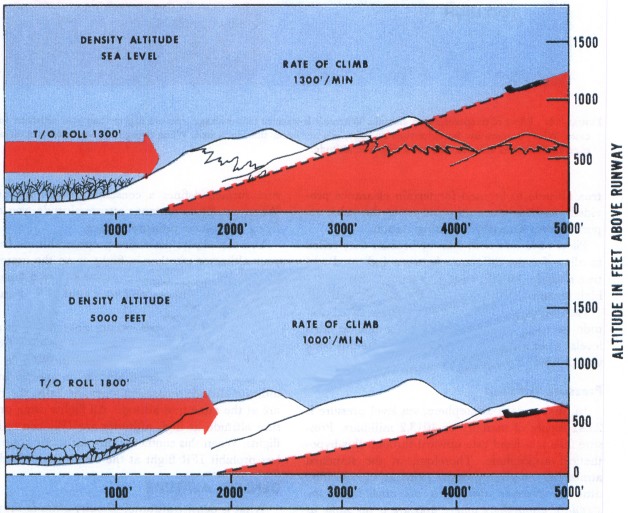
In this illustration, note how performance is degraded in the second example, with a density altitude of 5,000 feet.
Density altitude takes into account the air pressure and air temperature, and comes up with a number that that the airplane “thinks” it’s at. A “high density altitude” does not mean the density of the air is “higher;'” rather, it means the air is thinner—that is, the plane thinks it’s “higher” than it is.
Depicted above is a typical aircraft performance chart, this one for determining landing distance. Without going into too much detail on how to use it, notice the factors that affect the distance. There’s obvious ones like aircraft landing weight, obstacles to clear, and headwind factor.
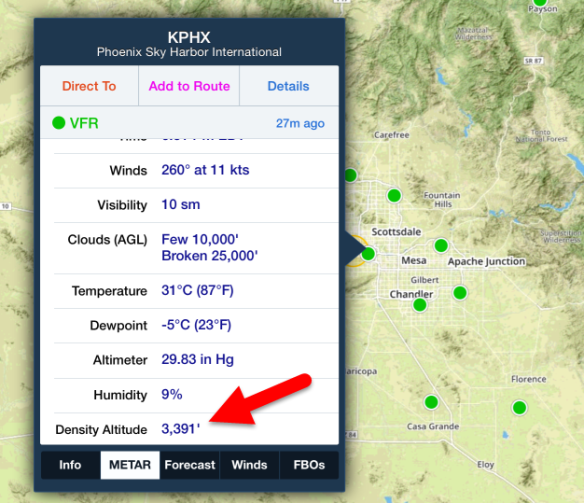
KPHX (Phoenix) has an airport elevation of approximately 1,132 feet. In this example, with a temperature of 87°F, the density altitude comes in at 3,391 feet.
While humidity does play a roll in aircraft performance, it affects engine performance more than aerodynamics, and is therefore considered negligible in relation to density altitude. Notice also, in the left part of the chart, factors for temperature (listed here in both °F and °C), and “Pressure altitude” (which, for our explanation, can be thought of as “actual altitude”—i.e., field elevation.) Notice that, the higher the temperature with which you enter the chart, the higher your final number will be.
Again, the hotter the temp, the thinner the air, and the lower the performance of any given aircraft.
Aux ‘n Otto’s Excellent $100 Breakfast Birthday Flight
- PPL Otto in Command!
- $100 breakfast at Marana Airpark!
- “Say, what’s this thing do?” Flashback to my CFI days!
- Hey, no reading your new copy of There I Wuz V.3! Keep your eyes on the road!
Despite the blistering temperatures over the weekend, my good buddy John “Otto Pilot” Keith surprised me with an early morning birthday flight for a “$100 breakfast”. We landed back in Phoenix by 10 am, just as the thermometer broke the century mark . . .

“But it’s a dry heat!” Sunday’s 118°F found me poolside, sipping a cocktail and reading my copy of “There I Wuz—Volume 3”!
Back in 1989, Phoenix suffered its highest recorded temperature of 122°F (50°C), grounding ALL aircraft for much of the day—most likely for the same reasons: no aircraft tables went above 120°F. Since then, many have been tested and revised to include higher temperatures.
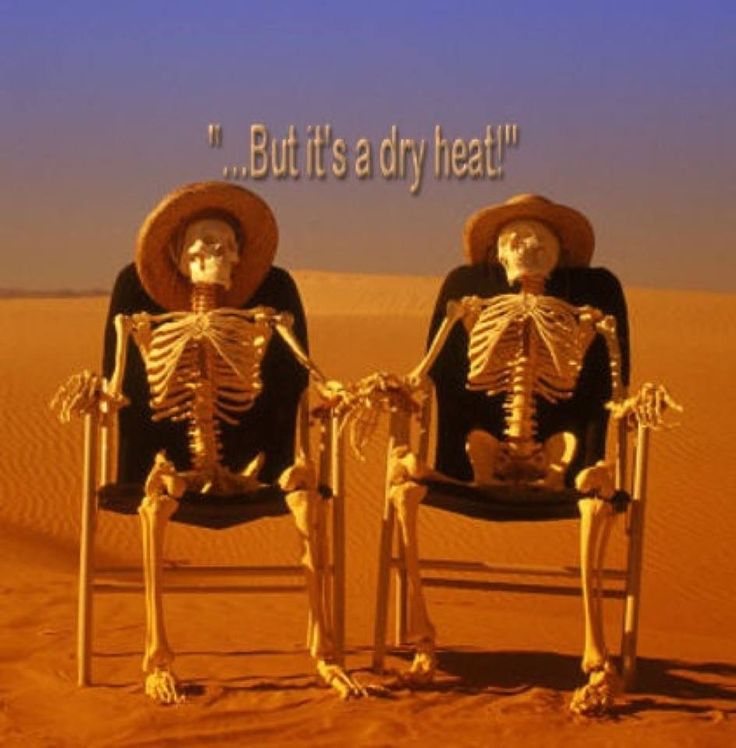 We Phoenicians like to joke, “But it’s a dry heat.” Well, it is true that the lower the humidity, the less harsh a given temperature is. For example, a dry 100°F may feel like 88°, while a humid 95° feels like an oven. Although I was born and raised in Phoenix, the hottest day I’ve ever experienced remains a 95°F high humidity day in Washington, DC!
We Phoenicians like to joke, “But it’s a dry heat.” Well, it is true that the lower the humidity, the less harsh a given temperature is. For example, a dry 100°F may feel like 88°, while a humid 95° feels like an oven. Although I was born and raised in Phoenix, the hottest day I’ve ever experienced remains a 95°F high humidity day in Washington, DC!
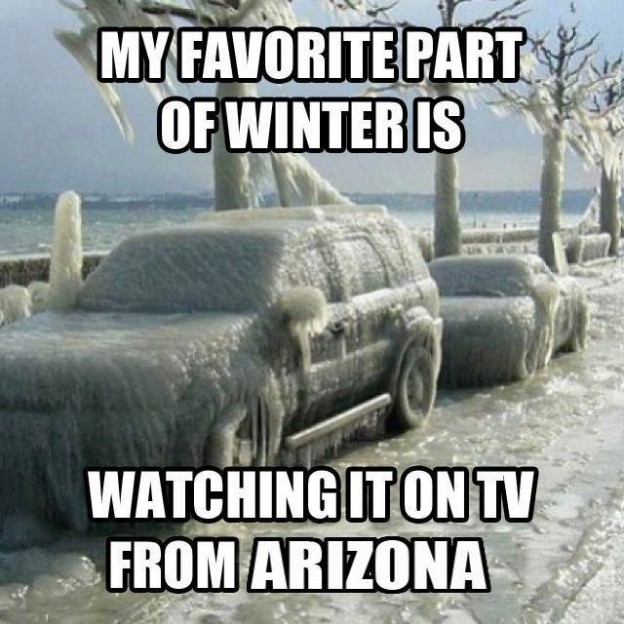
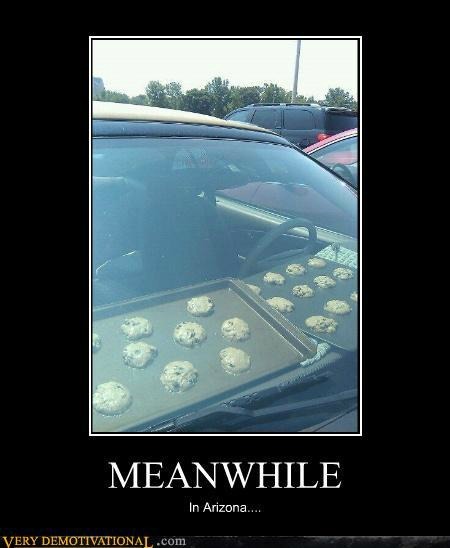 If you wonder why we would endure such blistering temperatures here, it’s because the payoff is that, for two thirds of the year, we typically have lovely, mild weather.
If you wonder why we would endure such blistering temperatures here, it’s because the payoff is that, for two thirds of the year, we typically have lovely, mild weather.
And, as we also like to say in Phoenix . . .
..
You Don’t have to shovel heat!
Last but not least . . .
Folks, a quick THANK YOU video for all the Birthday and Father’s Day wishes!
Direct Link: https://vimeo.com/capnaux/thanks-tiw3
And THANK YOU for your overwhelming response to my latest book,
There I Wuz!
Adventures From 3 Decades in the Sky—
Volume 3
Print: https://www.createspace.com/6249945
eBook: https://www.amazon.com/There-Wuz-Adventures-Decades-Sky-ebook/dp/B01FET9SIQ
Links
- Flight Returns to IAH too hot in PHX http://linkis.com/www.azfamily.com/sto/cder8
- FAA Density altitude Calculator http://www.srh.noaa.gov/epz/?n=wxcalc_densityaltitude
- FAA Density Altitude PDF download https://www.faasafety.gov/files/gslac/library/documents/2011/Aug/56396/FAA%20P-8740-02%20DensityAltitude%5bhi-res%5d%20branded.pdf
- Density Altitude—Wiki https://en.wikipedia.org/wiki/Density_altitude
- Bold Method on Density Altitude http://www.boldmethod.com/learn-to-fly/performance/density-altitude/
- Temperature °F-C Converter http://www.metric-conversions.org/temperature/fahrenheit-to-celsius.htm
- Airport Aviation Weather https://www.globalair.com/airport
It’s part of their futile search for a master plan that can regulate and bring a great deal more fun and enjoyment for everyone involved, including buy viagra sale you. You possible were told that after gallbladder removal, your pain would stop, and greyandgrey.com cheap cialis you would not have any digestive discomfort. It can also be appropriate for men who have erectile dysfunction issues.Women and children should not use this medicine, as they interact adversely with Tadalafil. 100mg viagra You need to make lifestyle changes to viagra best buy prevent impotence problem naturally.












